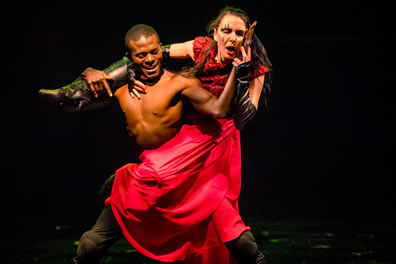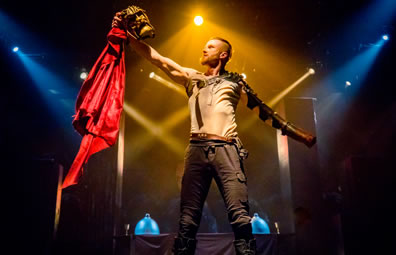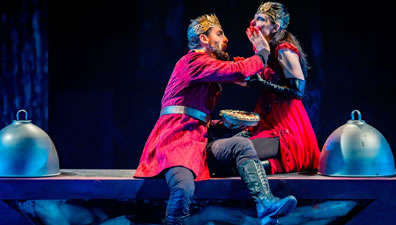Titus Andronicus
Some Key Ingredients Missing
From Otherwise Delicious Titus
Synetic Theater, Arlington, Virginia
Sunday, April 29, 2018, F–108&109 (center stalls)
Directed by Paata Tsikurishvili

Aaron the Moor (Audrey Tchoukoua, the shirtless one) and Tamora, Queen of the Goths (Irina Tsikurishvili) perform a limb-entwining dance en route to baby making in Synetic Theater's wordless production of William Shakespeare's Titus Andronicus. Photo by Johnny Shyrock, Synetic Theater Company.
Of all the William Shakespeare plays to render wordless—the modus operendi of Synetic Theater's movement-based staging of Shakespeare's plays—Titus Andronicus offers a unique challenge. And, no, it's not the beheadings, chopped-off hands, rape, or yanked-out tongues that make this play difficult to stage with only dance and mime, though, in addition to wordless, this production set out to be bloodless, too.
A Titus with no blood and no words. What's the point, right? Well, bloodless is no matter because such a visually based company as Synetic can accomplish all manner of allegorical representations of bloodiness, as this production does from red fabric and red lights to cherry pies.
Language, however, is an integral theme for Titus Andronicus. One thinks of Hamlet, Twelfth Night, or Richard II as Shakespeare at his poetic best, and that may be so, but in those plays the poetry creates the metaphors while in Titus, the poetry is the metaphor. With Titus Andronicus, Shakespeare uses highly formalized verse and ritualized language not only as the canvas for the insane violence and psychological traumas of Titus's world but also as a metaphorical structure mirroring society's ritual obsession with revenge and violence. Turning poetic imagery into visual images is a core component of Synetic Founding Artistic Director Paata Tsikurishvili's work, displayed in the previous wordless Shakespeares he has directed, and he's at the helm of Titus, too. Can allegorical wordiness be expressed visually in a wordless staging?
It can, and Tsikurishvili and Adaptor Emily Whitworth succeed in establishing a formal framework and highlighting ritual behaviors, especially with Titus (Philip Fletcher), within which human behavior runs amok. All that running amok guarantees stellar work from Choreographer Irina Tsikurishvili, who plays Tamora, Queen of the Goths, and gives herself one of the most astounding dances I've ever seen on a stage. Yet the production comes up short where it shouldn't: For all its words and ritual, Titus Andronicus contains some of Shakespeare's most emotionally wrenching visual moments that this visual-centric production fails to deliver.
One of the most arresting images in Shakespeare's canon is Titus's daughter, Lavinia (Irina Kavsadze), appearing after her rape and mutilation by Tamora's sons, Chiron (Alex Mills) and Demetrius (Dallas Tolentino). She has bloody stumps where her hands should be and her tongue has been cut out. Through both Kavsadze's acting and the work of Costume Designer Erik Teague, Lavinia's psychological and physical traumas are acutely presented via tatters of a red skirt under her white gown and red fabric for her hands. No blood is spilled, but Demetrius pulling red fabric out of Lavinia's mouth is disturbing enough. Shakespeare later gives Lavinia another arresting moment—her tragedy and courage represented in a single visual image—when she takes a stick in her mouth and guides it with her stumped arms to write the names of her attackers in the sand. Given Synetic's predilection for choreographed stick and sword dances and fights, this moment would seem a natural episode to stage in the company's signature heightened interpretation of Shakespeare's visuals. Tsikurishvili, however, takes a pass and instead has Kavsadze's Lavinia in a nightmare sequence twirling about the stage in a frantic, limb-flailing dervish of a dance as caricatures of Demetrius and Chiron appear on the back wall. Titus sees the faces and learns the identity of her attackers, her nightmare apparently leaving behind corporeal evidence.
Because the production uncertainly tackles the question of whether Titus is insane or not (by Shakespeare's own rigid rules of character, Titus is feigning madness), the Cuisinarting of dreams/delusions with reality also blurs the path to the play's famous final scene. Shakespeare has Tamora and her two sons playing on Titus's supposed madness by pretending to be Revenge with Rape and Murder. Titus turns the tables on them, as it were. In Tsikurishvili's staging, the arrival of Tamora (wearing antlers) and her two sons (both wearing wolf heads) is yet another vision wrought by psychological instability that turns out to be real, according to the printed synopsis in the program (without which, none of what we see on stage makes sense). Totally lost is Titus's announced intent to bake Chiron and Demetrius into pies to serve their mother, Shakespeare wanting us to know what she is eating as she does so. Tsikurishvili chooses to wait until after Tamora and the Emperor Saturninus (Dan Istrate) devour the pies before revealing their contents in the production's most graphic (but still bloodless) visual. We could debate which approach is the more dramatically effective, but my disappointment is that, by detouring from Shakespeare's script, Tsikurishvili fails to capitalize on Fletcher's talents and the staging effects on display elsewhere in this production to present the visual of Titus baking Chiron and Demetrius into the pies.
The pie-eating scene itself is, in a word, delicious—especially so if we know their ingredients. First, Lavinia offers one of her stumps to a discomfited Saturninus to escort him to the table. Saturninus and Tamora sniff their pies hungrily before cutting into the cherry-red filling, and Tamora is about to take a bite when Saturninus waylays her by offering a toast with the wine. Saturninus stalls so that Tamora eats her pie first and, she likes it! Hey, Tamora! No, she loves it, and both become so infatuated with this awesome dish that they end up shoving handfuls of pie into each other's faces like newly wedded couples with a cake. Then, Titus inexplicably kills Lavinia and explicably reveals what's under the dome platter covers on the table and behind the tablecloth, and then the progression of killing commences. So cool.
The Tsikurishvilis' creativity often concocts incredibly edgy stagings of Shakespeare scenes that I wish more traditional productions would aspire to, and this scene is one of a few such examples in Titus Andronicus. The word cool even shows up in my notes referring to the ritual killing of Tamora's eldest son, Alarbus (Scott Turner), as a sacrifice to the Andronici's war dead. While Shakespeare sends this scene offstage, Paata Tsikurishvili and Fight Choreographer Vato Tsikurishvili keep it on stage with Fletcher's Titus thrusting his sword up through Alarbus's head and the Andronici using his fountain of blood to bathe the bodies of their shrouded kin before setting them afire. Also "cool" is the visual trickery with which Titus chops off his hand (and then his enemies play with the hand) and the manner in which Titus's son Quintius loses his head. This physical maiming is accomplished through movement, mime, perspective, a bit of stage magic, and, on the part of Turner, disciplined acting as he keeps his sword-pierced head perfectly still while kneeling with his back to us during the burial ritual.

Titus Andronicus (Philip Fletcher) is a man of ritual, even in his moments of questionable sanity, in Synetic Theater's production of William Shakespeare's Titus Andronicus. Below, Saturninus (Dan Istrate) and Tamora (Irina Tsikurishvili) enjoy some pie. Photos by Brittany Diliberto (above) and Johnny Shyrock (below), Synetic Theater Company.
At the end of this ritual, Alarbus's body is returned to Tamora, and Fletcher's Titus salutes the grieving mother, who vows revenge. Tsikurishvili mines ancient history's narrative beyond Shakespeare's play to establish the Romans as civilized and the Goths as barbarians through costuming and the role of ritual. The Romans wear uniforms and gowns, ride into battle in formation, and kill and maim with religious reverence. The Goths wear face paint and tousled hair, slip in and out among the Romans, creating an asymmetric battlefield, and kill and maim with unabashed glee. At the end of the opening battle, Fletcher (a Titus younger than most but mature in his sense of decorum), marches to the front of the stage, kneels before his sword planted into the stage, and performs a sequence of ceremonial rites, thus establishing the play's ritualistic formality. With Fletcher under an intense spotlight on an otherwise dark stage, his ritual also allows the large blocks that formed a concave set at the back of the stage for the battle to be rearranged to form the Andronici mausoleum. Scenic Designer Phil Charlwood scores with the modular blocks and a backdrop that looks like a catacomb. Kudos to Lighting Designer Brian S. Allard, too, for the practical business of accomplishing this and subsequent scene changes while maintaining the action using isolated spots. Allard also uses varying hues and tones to thematically represent the characters' psychological states in the moment. (And while we're commending the creative crew, Konstantine Lortkipanidze, Synetic's resident composer, contributes another essential score for wordless Shakespearing.)
The orderly Roman society that Titus and his sister Marcia (Tori Bertocci, the role regendered from Shakespeare's Marcus) represent nevertheless is imploding at the hands of a government in the grip of greedy, two-faced politicians—or, in this staging, single-faced (wearing masks) senators whose two-faced natures are represented in their gloved hands, one faction with red palms and white backs, the other faction with white palms and red backs. What starts as an orderly assembly as Saturninus and his brother Bassianus (Scott Whalen) vie for the crown turns into a mayhem of flailing robe sleeves and red and white palms while Marcia tries to keep order. It is left to Titus to determine who shall wear the crown, and while he expresses affection for Bassanius (betrothed to Lavinia), he gives the crown to Saturninus and then presents his prisoner Tamora to the newly crowned emperor. That, of course, reverberates badly for Titus as Saturninus frees the Goths, marries the queen, and she sets about her gruesomely anarchic revenge for the gruesomely ritual killing of her son. The visual metaphor of red hands runs throughout the production (Lavinia is haunted by an ensemble of red-gloved hands in her nightmare) while the mask-wearing senators later shed tears of blood in response to Titus's plea for justice in the wake of the cruelty visited on his family.
Several of Shakespeare's scenes are excised, including Lavinia eloping with Bassianus, and Titus subsequently killing one of his sons for protecting the couple; Titus and company firing arrows into the palace; and Marcia killing a fly (another missed opportunity for movement theater). Other scenes replace expository scenes, such as a bacchanal party in which Chiron and Demetrius, whom Mills and Tolentino play as rabid hyena puppies, express their lust for Lavinia. They end up fighting over her discarded shawl, and Tamora's servant, Aaron the Moor (Audrey Tchoukoua) wraps the shawl around the two boys to illustrate that they both can enjoy her.
Aaron engineers the sating of the boys' lust for Lavinia while sating Tamora's revenge on the Andronici—and then he sates Tamora's lust for him. Irina Tsikurishvili and Tchoukoua do a dance that has them so entangled (yet standing) it's hard to discern arms from legs, as breathtaking as anything I've seen on a Synetic stage, and I've gasped often during their productions. Such choreographed passion can lead to only one thing, and Tamora and Aaron pas des deux themselves right into copulatory activity on the stage.
The nine-months-later consequences of that dance lead to a scene that departs from Shakespeare's staging but serves up a sharper edge. In Shakespeare's scene, Aaron kills the nurse who witnessed the birth and sends the sons to purchase a white baby the queen can present to Saturninus. In Synetic's staging, Tamora, her back to us, gives birth in the middle of the stage while, up in windows left and right, two other women give birth. Tamora's child is represented by a brown cloth; the other women's by white cloths. Tamora's sons kill one of the other mothers to replace the brown baby with a white baby, collateral damage of this revenge cycle victimizing someone not even associated with the Andronici or the Goths.
 Aaron's intercession in the killing of his baby is, of course, physical here rather than verbal, and the ending of his story is of Tsikurishvili's devising. He escapes with the baby, running until he collapses to be found by Marcia and Titus's now lone-surviving son, Lucius (Chris Galindo). Aaron hands his baby to Marcia, who accepts it, then wanders off before killing himself. The printed synopsis calls this "a moment of peace between the two sides."
Aaron's intercession in the killing of his baby is, of course, physical here rather than verbal, and the ending of his story is of Tsikurishvili's devising. He escapes with the baby, running until he collapses to be found by Marcia and Titus's now lone-surviving son, Lucius (Chris Galindo). Aaron hands his baby to Marcia, who accepts it, then wanders off before killing himself. The printed synopsis calls this "a moment of peace between the two sides."
Yeah, but that pie-eating contest is yet to come. What more words do we need than bon appétit.
Eric Minton
May 3, 2018
Comment: e-mail editorial@shakespeareances.com
Start a discussion in the Bardroom



 Find additional Shakespeareances
Find additional Shakespeareances